Arable Farmer-led Group: climate change evidence
A summary of existing evidence around the arable sector, including greenhouse gas emissions produced by the Rural and Environment Science and Analytical Services (RESAS) division.
2 Greenhouse Gas Emissions and Biodiversity
2.1 Sector Emissions
The Scottish Government has committed to reaching net zero emissions by 2045, including a reduction of 75% by 2030. Whilst a number of countries have adopted net zero targets by on or around 2045, Scotland's 2030 target is particularly ambitious and requires quick action.
Scotland has a legal requirement to meet these goals, and every industry must adjust to contribute to reducing emissions. The Greenhouse Gas (GHG) inventory measures the domestic emissions, i.e. those produced in Scotland. It is the key data source against which Scottish Government measures its progress against its net zero targets. Emissions arising from goods produced in Scotland and exported overseas for consumption are counted in the Scottish GHG inventory. Emissions arising from goods produced overseas and imported into Scotland for consumption are not counted in the Scottish GHG inventory.
In 2018 total Scottish emissions were 41.6 million tonnes of carbon dioxide equivalent (MtCO2e). The 2019 figures are scheduled to be published in summer 2021.
In 2018 emissions from agriculture were 7.5 MtCO2e, or 18% of Scottish emissions. The sectoral envelope as set out in the Climate Change Plan update requires agricultural emissions reduce by 2.4 MtCO2e to 5.3 MtCO2e[11] in 2032, the equivalent of a 31% reduction from 2018 levels. As shown below this requires agriculture to reduce emissions at a pace nearly four times faster than historic reductions. Progress towards delivering the plan will be part of statutory annual reporting at a sector-by-sector level to the Scottish Parliament from May 2021 onwards.
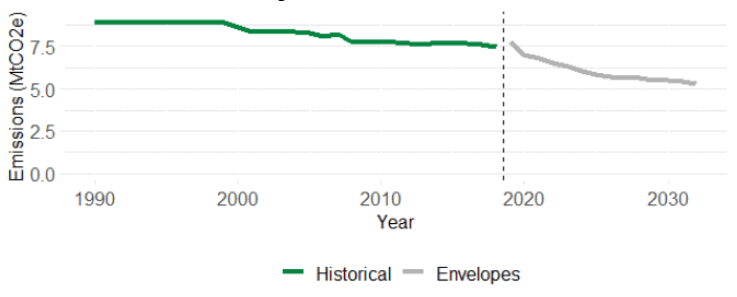
Source: Scottish Greenhouse Gas Emissions 2018 - gov.scot (www.gov.scot), Securing a green recovery on a path to net zero: climate change plan 2018–2032 - update - gov.scot (www.gov.scot)
Note: there is a small break in the series due to a slight mismatch in the historic data and the forecast envelopes
2.1.1 Emissions from Arable Farms
The GHG Inventory for agriculture includes emissions from fertilisers, crop residues, and managed soils. It does not explicitly break down all relevant emissions by sub-sector. Therefore, we have estimated emissions from arable of 1.61 MtCO2e, 21% of agricultural emissions. More detail on how we have done this is in Annex C. Unlike other sectors, emissions from arable are mainly from carbon dioxide and nitrous oxide, with less than 1% from methane. Between 1990 and 2018, emissions from arable have risen by 1%.
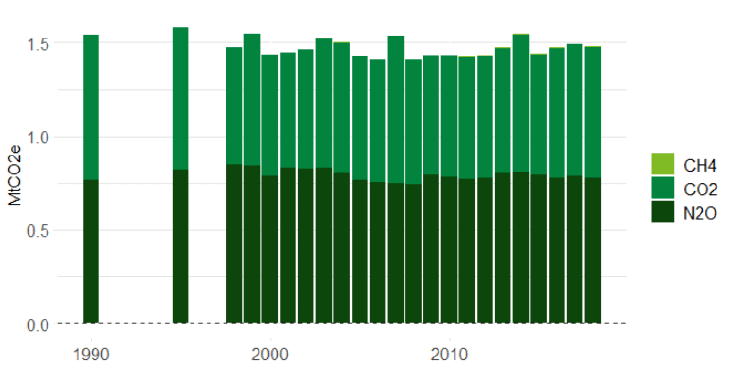
Source: Scottish Greenhouse Gas Emissions 2018 - gov.scot (www.gov.scot)
2.1.2 Sources
The chart below shows how the 2018 emissions from arable break down by source and pollutant.[12] Farm vehicles are the largest source, contributing 29% of emissions from arable. The next largest source is cultivation of organic soils, contributing 15%.
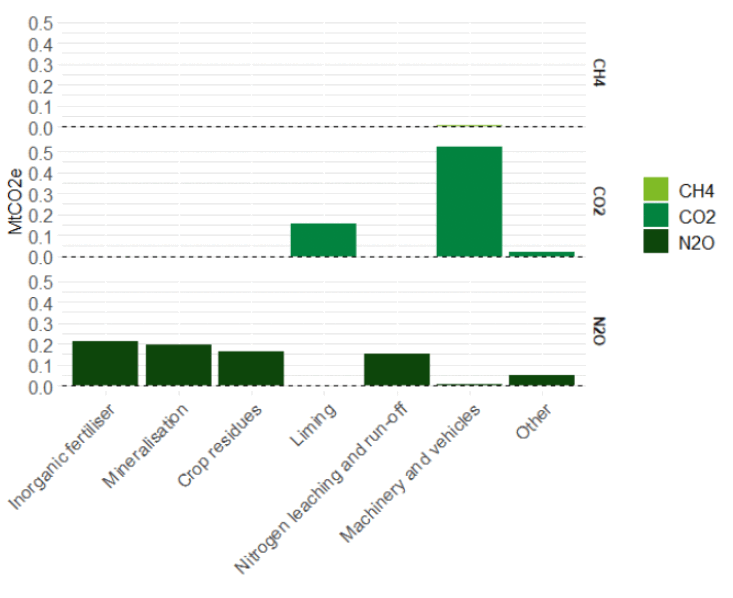
Source: Scottish Greenhouse Gas Emissions 2018 - gov.scot (www.gov.scot),
RESAS classification based on ADAS data
Over time, the largest reductions in emissions by source have come from inorganic fertilisers. However, emissions from mineralisation/immobilisation have more than doubled in the same period. This increase is larger than the decrease from inorganic fertilisers.
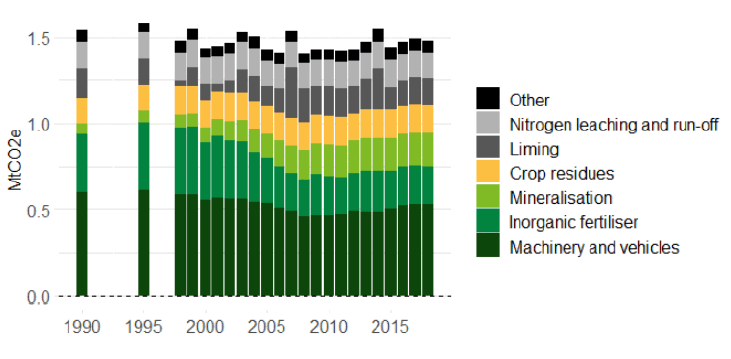
Source: Scottish Greenhouse Gas Emissions 2018 - gov.scot (www.gov.scot),
RESAS classification based on ADAS data
2.2 Options for Reducing Emissions
2.2.1 Potential Savings
Research undertaken by CXC and SRUC on behalf of Scottish Government assessed potential savings from mitigation measures that could be applied in Scotland and the likely maximum uptake that could be achieved. The maximum uptake figures below are shown as a percentage of arable and grassland.[13] The report did not assess timescales for uptake of measures, which will be influenced heavily by factors like behaviour change and policies. Table 7 summarises measures that could be applied in the arable sector. Estimates of aggregate emissions savings have been added based on the 2019 areas.
| Area 2019 | Mitigation measure | Maximum Uptake 2050 | Per ha mitigation (kg CO2e) |
Aggregate Mitigation (MtCO2e) |
|---|---|---|---|---|
| 1,863,000 ha | Grain legume rotations | 5% | 553 | 0.05 |
| Improved crops | 24% | 13 | 0.006 | |
| Intercropping | 6% | 89 | 0.001 | |
| Nitrification and urease inhibitors | 81% | 71 | 0.11 | |
| pH management | 33% | 112 | 0.07 | |
| Slurry injection | 17% | 26 | 0.01 | |
| Slurry trailing hose | 17% | 7 | 0.002 | |
| Variable rate nitrogen & lime application | 17% | 151 | 0.05 | |
| Additive Total | .. | 0.3 |
Source: Marginal abatement cost curve for Scottish agriculture (climatexchange.org.uk)
Strictly speaking the 'additive total' overstates the savings as some measures may interact and reduce the impact of other measures. Whilst overall for agriculture in the CXC report, these interactions were assessed to be relatively low they mainly occur in the measures relevant to the arable sector and therefore may overestimate the total reduction.
This is because some measures cannot be carried out on the same land in certain combinations, or may be less effective if they are. For example, soil pH management can be applied to a maximum of 33% of agricultural land, and variable rate nitrogen and lime application can be applied to a maximum of 17% of agricultural land – however, they cannot be applied together, meaning the true maximum for both measures is 33%. As a result, constraints may slightly overestimate the mitigation potential overall. Mainly this is related to the combined uptake of slurry measures, pH management, variable liming, nitrification inhibitors and legumes on the same land. Further explanation is available on page 14 of the CXC report.
If each of these measures were applied to their maximum potential as identified in the report, estimated reductions from emissions based on current levels of arable land would be up to around 0.3 MtCO2e. However, the potential interactions outlined above may reduce this by around a fifth, to 0.24 MtCO2e.
This would be up to a 15-19% reduction in terms of 2018 emissions from the arable sector or 10-12% of the 2.4 MtCO2e reductions required by agriculture by 2032 with the remaining 88-90% needed to come from elsewhere in the sector. This would not be sufficient to meet the equivalent of the arable sector's share of the necessary reductions. A reduction of 2.4 MtCO2e is equivalent to a 31% reduction from 2018 levels. Therefore, even if all agricultural sectors were to achieve an equivalent 15-19% reduction in their emissions this would not be sufficient, by around a half, for the agriculture sector to meet its envelope by 2032.
The Climate Change Committee states changes in farming practices, woodland planting and reductions in livestock numbers are all required to achieve net zero. Their advice also highlights three key changes required to reduce agricultural emissions:
1 - Diet change with their main pathway to net-zero assuming a 20% reduction in UK consumption of red meat by 2030, rising to 35% by 2050
2 – Low-carbon farming practices, similar to those outlined above
3 – Productivity measures to improve crop yields and reduce stocking rates
It is important to note that the figures above are average estimates that were provided for Scotland as a whole. On an individual farm basis, both the mitigation and the net costs (below) can be very different and some measures above cover a wide range of possible actions which would be demanding to assess individually. Therefore the GHG benefits achieved and costs could vary widely.
Further details on each of these measures, such as costs, underpinning assumptions, constraints and potential uptake can be found on pages 12-13 of the CXC report and in the Annexes on pages 43-53. They have also been collated into Annex D for ease.
As set out within the CXC report, there is scope for all sectors in agriculture to mitigate their operational GHG emissions through other practices and alternative land use such as those to encourage carbon sequestration.
2.2.2 Costs
Some of these measures would involve the purchase of capital equipment with upfront costs. The table below shows the net costs to farmers including capital costs on an average annual basis. These do not include any wider costs such as those to Government or Research and Development from developing measures. Negative figures below show a net saving to the farmer, i.e. if implemented they would provide a financial saving to the farmer as well as a reduction in emissions. Based on current levels the average potential net cost to the arable sector is around £9m which is equivalent to 2% of the value of cereal output, where the majority of emissions are associated.
| Area 2019 | Mitigation measure | Maximum Uptake 2050 | Per unit annualised cost (£) | Aggregate Cost (£m) |
|---|---|---|---|---|
| 1,863,000 ha | Grain legume rotations | 5% | 406.00 | 35 |
| Improved crops | 24% | -10.17 | -5 | |
| Intercropping | 6% | -45.18 | -5 | |
| Nitrification and urease inhibitors | 81% | 20.67 | 31 | |
| pH management | 33% | -45.00 | -27 | |
| Slurry injection | 17% | 21.35 | 7 | |
| Slurry trailing hose | 17% | 8.16 | 3 | |
| Variable rate nitrogen & lime application | 17% | -93.57 | -30 | |
| Additive Total | .. | 9 |
Source: Marginal abatement cost curve for Scottish agriculture (climatexchange.org.uk)
2.2.3 Current Uptake & Implementation Constraints
This section contains a brief summary of some of the key issues relating to each of the measures outlined in Tables 7 & 8 above drawing heavily on the CXC report.
2.2.3.1 Grain legume rotations
Legumes source nitrogen directly from the atmosphere, meaning very little (or no) nitrogen fertilisers are needed. They also provide some of this nitrogen to crops grown alongside and after them, reducing the need for nitrogen fertilisers.
Frequency of rotation depends on different factors according to the legume. Some legumes can only be grown once every few years to reduce risk of disease, and others may delay yields. Different types of soils may also mean legumes are unsuitable for some areas.
In 2016, legumes for human consumption were grown on 1.7% of the arable crop area in Scotland. It is assumed that this could increase to 5% of the arable area.
2.2.3.2 Improved crops
Nitrogen fertilisation is vital to achieve current yields for most crops, but a significant proportion (nearly half) is lost to the environment, causing multiple environmental problems. Using crops which are more efficient in utilising the nitrogen fertiliser reduces GHG emissions and pollution, and reduce economic loss due to fertiliser lost to the environment.
Nitrogen-use efficiency varies between individual plants of the same species, and some can be selected for further breeding. New cultivars such as perennial wheat or disease resistant varieties can help to retain more carbon in the soil as well as reduce fertiliser, pesticide and fuel use. Currently, main research streams are being carried out for nitrogen-fixing cereals which could substantially reduce the need for nitrogen fertilisation in these plans.
There is assumed to be a seed price premium of around 10% for improved crops, but beyond that there are no further costs and this measure is applicable to all crops. Currently, uptake is assumed to be zero, but could be implemented widely on arable areas.
2.2.3.3 Intercropping
Growing a legume crop alongside a cereal crop reduces the need for fertiliser, as the legume crop sources nitrogen directly from the atmosphere and provides some of this to plants grown in the same area. In the UK, intercropping is typically pea or fava bean grown alongside spring oats, spring barley, or spring wheat. Currently, intercrops are usually used as feed for livestock.
Costs may be a constraining factor as pea seed is around 50% more expensive than barley seed. While there are no reported figures on current uptake, there is growing interest in intercropping, and it possible that in future grain will be separated and used for human consumption, increasing incentive to adopt intercropping. Future uptake can be expected to be high, as intercropping is applicable to 43% of winter and spring oat, and 100% of spring non-malting barley.
2.2.3.4 Nitrification and urease inhibitors
Chemical inhibitors improve the availability of nitrogen fertilisers for plants and reduce both GHG emissions and nitrate leaching. Urea in combination with inhibitors can further reduce emissions. These can be injected into the soil, applied as a coating, mixed into slurry, or spread after grazing.
There is little data available on current use of nitrification and urease inhibitors in Scotland, and in the MACC model uptake was assumed to be 0%. However, costs are relatively low for implementation.
2.2.3.5 pH management
Soil pH plays an important role in crop productivity and regulating and modifying emissions, including improving fertiliser efficiency. Costs include the purchase of lime, spreading and soil analysis, and provide a benefit from additional income due to increased yield.
Currently, 64% and 30% of farms carried out pH testing on arable and grazing land respectively. A survey showed that of the sample, 57% of grassland soils and 34% of arable soils had low or very low pH values. This suggests that uptake can be expected to be fairly high, at around 50% on grasslands and 30% on croplands.
2.2.3.6 Slurry injection and trailing hose
Livestock slurry can be applied to soil using a range of techniques, with the most common in Scotland currently being a low trajectory splash plate. Implementation of bandspreading and injection techniques involve installing pipes and/or machinery to apply slurry directly to the surface of the soil, and can reduce crop contamination and ammonia emissions.
There is a requirement for capital investment to implement this measure, which may be a constraining factor for some farm businesses. However, this measure is already being used in many farms across Scotland, with 28% of slurry bandspread and 3.5% injected in 2016. The CXC report assumes that this measure can be applicable to around half of all organic manure applications in Scotland and indicates at a UK level such applications comprise just over 40% of the total. The main method in Scotland at present is with a low-level splash plate, so there is room for significant increase in uptake.
2.2.3.7 Variable rate nitrogen & lime application
Where soil pH and other crop-growing conditions are highly variable, tailoring nitrogen and lime application can save resources and enhance yield, as well as reducing GHG emissions. Precision farming technologies can tailor the rate of inputs to soils within one square metre.
Current adoption is around 8% across the UK, likely lower in Scotland due to smaller arable farms. There are capital costs associated with implementing and maintaining this measure.
2.3 Biodiversity
2.3.1 What do we know about biodiversity?
The Convention on Biological Diversity defines biodiversity as the variability among living organisms from all sources including within and between species and of ecosystems. It is vital to supporting humans by contributing to food production, manufacturing supplies, recreation, soil quality, and climate stabilisation. In December 2020 the Scottish Government published a Biodiversity Statement of Intent which includes proposals in relation to land use.
The Dasgupta Review of the Economics of Biodiversity commissioned by HM Treasury highlights that we are demanding more goods and services than nature can sustainably supply. This means global stocks of natural assets have been depleted. The review makes clear that increased biodiversity helps mitigate risks to economic prosperity and climate change. Acting immediately on biodiversity loss is significantly more cost effective than delaying action. We can respond by reducing our use of natural resources, increasing the efficiency with which we use them or increasing them through conservation and rebuilding.
2.3.1.1 What is the relationship between farming and biodiversity?
Agricultural intensification has negatively impacted biodiversity, particularly due to a trend towards homogeneity leading to fragmentation and loss of habitats. Overall biodiversity benefits from a mix of land use intensities as well as a mix of habitats[14] as shown below.[15] Land management practices can contribute to maintaining biodiversity, and have a negative impact where practices are intensive.
The UKG review states the relationship between farming and biodiversity is complex. Biodiversity can benefit farmers by improving productivity including soil health, and farming approaches can be tailored to benefit wildlife and biodiversity[16]. However, this is not always true: for example, an area of farmland may have high biomass, but low biodiversity[17].
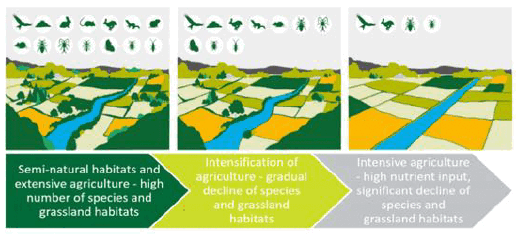
A change of land use can result in various impacts on biodiversity: for example, conversion from semi-natural grazing to forestry may be detrimental, as the diversity and richness of wildlife associated with the former can be considerable, whereas conversion from improved grassland (which can be poor for wildlife) to forestry is likely to make little difference[18].
Farmland is particularly able to deliver services such as energy sources, food production and recreation. However, the Natural Capital Asset Index shows that the natural capital[19] asset value of agricultural and cultivated land has been reducing over recent years. The Index is made up of quality (38) x quantity indicators (ie area) and the recent agriculture decline seems to be driven by a reduction in land designated arable land and market gardens[20].
Biodiversity varies across regions, land uses and species. A commonly used indicator for biodiversity is bird populations. Research by Nature.Scot shows that most wader species have seen significant declines while seed-eaters show stable or increasing long-term trends. Overall there has been an increase in the species that contribute to the farmland bird indicator since 1994, however losses have been found for some species including greenfinch, kestrel, lapwing, oystercatcher grey partridge and corn bunting.
| Species | Long-term trend | Short-term trend |
|---|---|---|
| Common snipe | Increase | Increase |
| Curlew | Decrease | Decrease |
| Lapwing | Decrease | Decrease |
| Oystercatcher | Decrease | Decrease (slowing) |
| Redshank | Decrease | Decrease (slowing) |
| Linnet | Increase | Stable |
| Skylark | Stable | Decrease (accelerating) |
| Tree sparrow | Increase | Increase |
| Yellowhammer | Stable | Increase |
| Corn bunting | Decrease | Increase |
Long-term changes in Scottish and UK farmland bird populations have been driven by many factors including intensification, reduced crop type diversity within farms and reduced spring-sown crops[21]. Pesticide use removes weed and insect food sources for birds, either directly or through the food chain and has also contributed to decline.[22] Agri-environment schemes have been in Scotland for around two decades, helping reverse impacts with results varying between species.
There are also concerns on declining populations of formerly widespread plants like cornflower and corn marigold and insects like butterflies and bumblebees on arable land.
Pollinators play an essential role in plant reproduction and ecosystem functions, and there are currently large worrying declines in their populations. The value of insect pollinators for crops has been estimated at £400 million p.a. in the UK[23]. The State of Nature in Scotland 2019 shows changes in farmland management in the past 50 years to have the greatest impact on nature include increased pesticides and fertilizer use, continuous cropping, changed sowing seasons and non-cropped habitat loss. Changes in food production patterns can cause invertebrate declines. Conversion to more intensive agriculture and agrochemical pollutants are key drivers.
Arable farming can support wildlife and agri-environment schemes aim to encourage this. Birds require winter food and shelter, sites for nesting and food supply through the summer[24]. Approaches can be particularly successful when management interventions at a field level target specific species e.g. corn buntings in Eastern Scotland[25].
Some of the options that appear to be most successful in terms of uptake include:
- Retention of winter stubbles for wildlife and water quality – which is supporting seed-eating birds helping maintain a stable trend for these birds[26]
- Stubbles followed by green manure – supporting birds and pollinators
- Wader grazed and mown grassland options – supporting waders, and other wildlife.
Arable fields can host thousands of species of insects and spiders. Some will be pests but others are natural predators of these pests, pollinators or can assist in the breakdown of organic matter. They are also a food source of some birds, bats, other mammals and amphibians. The balance between all these arthropods species is out of kilter in lots of our farmland, with knock on effects higher up the food chain, and for the farm business.
Hedgerows provide habitat for birds, butterflies, insects and small mammals, with 130 priority Biodiversity Action Plan species known to be associated with hedgerows[27] [28].
Field margins are strips of land, such as a hedge, between the field boundary and the crop. There is a body of evidence identifying their multiple benefits[29]. They can provide semi-natural habitat, areas for wild plants, for feeding, shelter and nesting for wildlife. Flower-rich field margins can encourage pollinators for crops and predators of pests. Buffers also help reduce the effects of runoff and soil erosion from farming operations. They can provide corridors across the landscape, linking other areas of wildlife habitat. Field margins can be left to naturally regenerate, as crop edges without herbicide or insecticide application, or cultivated and managed as margins to deliver particular benefits. Mowing or cutting at the end of the growing season can help maintain diversity of flowers[30].
Water Margins are essential to prevent soil erosion and the transfer of pollutants to watercourses. Direct run-off, leaching and spray drift can lead to pollutants, sediment, pesticides entering water courses and negatively impact water quality. Vegetation at the water margin can contribute to water quality and biodiversity[31] [32].
NatureScot has a project working with clusters of farmers and crofters to test outcome based innovative approaches to supporting biodiversity for environmental outcomes. Two of the pilots are in East Lothian (focused on hedgerow restoration) and in Strathspey (waders)[33].
Other good examples can be seen at:
- Strategic Cereal Farm Scotland, a research project with Balbirnie Home Farm on reducing synthetic inputs on-farm and improving soil guided by regenerative principles - cover crops, min till and livestock integration. It uses soil and plant health metrics to direct inputs via diverse rotations, including field veg, potatoes and cattle.
- Farming and Nature – Whitmuir Estate case study
- Sustainable Cropping Systems: Both JHI and SRUC have undertaken significant research, e.g. JHI is running a project on the use of legumes with cereals[34]
- The Burren (Ireland) was the first to test payments by results. This is an agri-environmental programme that aims to conserve and support heritage, environment and its communities. The Burren focusses on management of species rich grassland and key indicator species/habitats.
- Corn Bunting Recovery - collaborative efforts by local farmers and estates in Angus and Fife using targeted greening and agri-environmental measures has helped the recovery of a threatened species with record breaking increases and expansion of the range. Management practices have included delayed mowing and fallows to protect nests and use of a corn bunting mix (including clover, legumes and cereal). [35]
- SEAMs (Sustainability in Education and Agriculture using Mixtures) project is developing a network of field sites across the main arable food production areas of Scotland. These sites are trialling crop mixtures, providing information on how to tailor the use of crop mixtures to different locations in Scotland. They provide a platform for knowledge exchange and learning. The sites are working farms spread across Scotland and the project is taking a participatory approach. More info here
- Durie Farm – Leven, Fife; an example of a farm's agroecological transition[36].
Contact
There is a problem
Thanks for your feedback